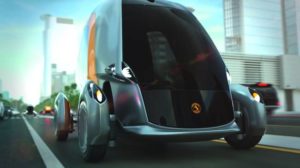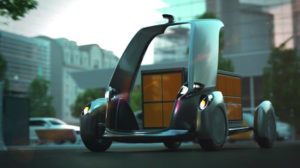A major automotive manufacturing company, Continental AG, released its vision of “the mobility of the future,” which includes fleets of driverless electric vehicles.

The BEE, which stands for Balanced Economy and Ecology mobility concept, is described as an “industrious worker bee for the urban mobility of tomorrow,” and is a two-seater electric self-driving vehicle that utilizes “flocking” or swarm behavior to transport people and goods in urban areas.
“BEE is designed as a vehicle for one or two people. It is electrically powered and buzzes around at speeds of up to 60 km/h. It can easily cover a distance of more than 350 kilometers every day. Without fuss and within a matter of minutes, it travels to your location when you summon it with your smartphone. It is designed to ensure tailored, stress-free and comfortable travel in the city of the future.” – Continental AG
The concept, which was launched at the Frankfurt IAA 2017 show, isn’t quite ready for primetime, though, as even if the vehicles could go into production immediately, the lack of “intelligent urban infrastructure” to support them in cities is lacking. The idea is that thousands of BEE vehicles would form “a swarm” of self-driving electric vehicles “in different sizes and with different features” in order to become a type of “public transport that really is for everyone.” The BEE vehicles could also function as autonomous cargo carriers (“a modern goods trolley”), as seen above.
However, between wavering public attitudes about autonomous vehicles, and the need to fully develop and deploy the necessary ‘smart’ infrastructure to fully embrace the technology, it might be years before this concept comes to fruition, if ever.
“This type of future mobility is largely already within our reach: With BEE, we are showcasing a highly realistic mobility concept whose technologies are already ready for production or in very advanced stages of development. But at the same time, we will not be seeing BEE on our roads in this decade because laying the foundations for future mobility is fundamentally linked to the development of smart cities and nations. The appropriate infrastructure is needed, both digitally and in the design of traffic routes. It requires the right legal framework. In this respect, we all still have a lot to do – and we are looking forward to the challenge.” – Kurt Lehmann, Corporate Technology Officer at Continental
Although the BEE is just a concept at this point, Continental does have working models of what it calls CUbE (Continental Urban mobility Experience), which is currently being trialed in the company’s Frankfurt campus, where it is being tested in “a city-like infrastructure with street signs, cross traffic, pedestrian crossings and curbs” that provides “an environment that is as realistic as possible.”
Original article at:
https://www.treehugger.com/public-transportation/continental-envisions-swarms-autonomous-electric-vehicles-public-transport.html


